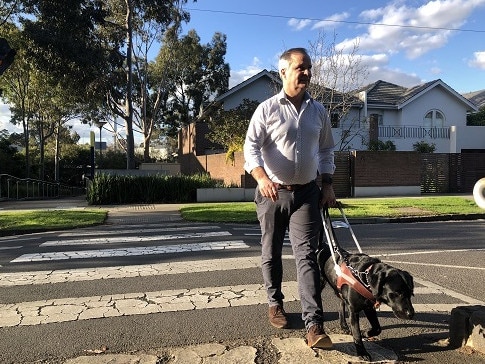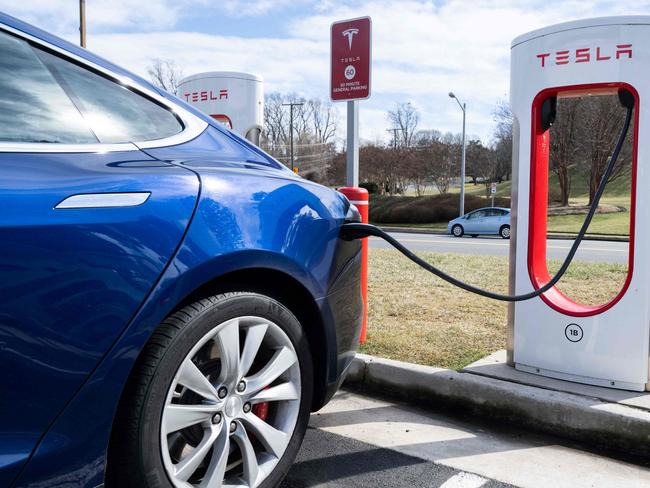Dangerously quiet EVs will be forced to emit noise at low speeds under new Australian law
One of the most unique aspects of driving an electric vehicle will soon change in a major way for Aussie motorists.
On the Road
Don't miss out on the headlines from On the Road. Followed categories will be added to My News.
For many motorists, one of the most striking features of driving an electric car for the first time is the uncanny silence.
But while a reduction in road noise may be a positive, advocates for the blind and low-vision community have long warned of the danger these heavy, silent cars pose to pedestrians.
After years of lobbying for the introduction of mandatory warning sounds, their efforts have paid off with the Albanese government announcing a new design rule to make quiet cars, trucks and buses travelling at low speeds safer for pedestrians.
From November 2025, new electric, hybrid and hydrogen fuel cell cars, trucks and buses must be fitted with an Acoustic Vehicle Alerting System (AVAS), a safety alert or sound that is emitted when the vehicle is travelling at low speeds in car parks, intersections and driveways.
“To cross a road when you don’t know if a car is there is a very frightening experience,” Chris Edwards, director of government relations, advocacy and NDIS for Vision Australia, told AAP this week.
Mr Edwards, who is legally blind, was struck by an EV several years ago while crossing at a busy road — an act he described as “Russian roulette”.
“I misjudged it and fortunately there were no major injuries but I was bruised and battered and my ego stung,” he said.

The new Australian Design Rule (ADR) requires the AVAS to be active when vehicles not using an internal combustion engine are travelling at or under 20km/h.
Under the rule, a vehicle moving forwards at 20km/h must emit a minimum overall AVAS sound of 56 decibels — roughly the level of an electric toothbrush — and no more than 75 decibels, or about as loud as a coffee grinder.
A vehicle fitted with an AVAS will not be any noisier than a conventional petrol or diesel vehicle.
“This is another example of our government’s commitment to road safety,” Infrastructure Minister Catherine King said in a statement.
“As more and more Australians choose to drive EVs, we are committed to ensuring that they are safe for both drivers and others using the road. This is a significant win for the blind and low-vision community who have long been advocating for alert systems like this to be introduced in Australia.”
The new ADR is expected to avoid around 68 fatalities, 2675 serious injuries and 2962 minor injuries by 2060 and is estimated it will save the Australian community $208 million, according to the government.
“In our efforts to transition to a cleaner, greener future, it’s important that we continue to prioritise our commitment to building an inclusive society,” said Social Services Minister Amanda Rishworth.

“Today’s announcement is another example of the Albanese government listening, including and responding to all sectors of society in our decision-making. It’s also another example of how making a reasonable adjustment for people with disabilities can actually make life better for everyone.”
The new rule comes after the government consulted on a draft impact analysis proposing a mandate for AVAS for light vehicles, and it was strongly supported by state and territory governments, the blind and low-vision community and vehicle manufacturers.
Tesla Australia has been contacted for comment.
Mr Edwards said Vision Australia had been calling for AVAS to be introduced in Australia since 2018.
The legislation brings Australia into line with international jurisdictions such as the European Union, US and Japan.
“We are ecstatic and congratulate the current federal government for listening to our concerns and acting on this very important issue as pedestrians who are blind or have low vision will be able to navigate public spaces with more confidence,” Mr Edwards said in a statement.
“It’s been a long road, but through persistence and putting the safety of Australia’s blind and low vision community in front of the government, we’ve achieved the result we wanted. We also recognise the proactive step the government has taken in expanding the requirement to include electric trucks, buses and other heavy vehicles.”
Research by Vision Australia in 2018 found 35 per cent of people who are blind or have low vision have had a collision or near miss with a silent vehicle.
“With electric vehicles predicted to make up 90 per cent of Australia’s vehicle fleet by 2050, it’s vital there is no delay in the AVAS requirement coming into force,” Mr Edwards said.

“Without this requirement, it would only become harder for people who are blind or have low vision to be active and independent members of the community.
“All pedestrians should have the right to feel safe and confident when navigating public spaces and today’s announcement is a significant step towards protecting that for people who are blind or have low vision. There is no doubt that this is an announcement that will save lives.”
Vision Australia chief executive Ron Hooton said the advocacy group was proud to have helped bring about the change.
“This is a historical day for Vision Australia and the entire blind and low vision community,” he said.
“For more than five years, we have been leading the push for the introduction of AVAS to electric vehicles in Australia and we’re proud to have helped play a role in a change that will have immediate benefit for our community.”
There are now more than 180,000 EVs on Australian roads, according to the Electric Vehicle Council’s 2023 recap, with 98,436 of those purchased last year — a more than doubling of sales from 2022.
Tesla dominated the market with its Model Y and Model 3 in first and second place, followed by the BYD Atto 3.
The number of charging stations in Australia also increased, from about 464 at the end of 2022 to 812 at the end of last year, including around 130 offering ultrafast charging at 100kW or above.
The EVC continues to advocate for Australia to aim for one million EVs to be on Australian roads by the end of 2027 — approximately 5 per cent of the total passenger and light commercial fleet.
“These targets would put Australia on a feasible pathway towards achieving around 2.5 million EVs by 2030 (equivalent to approximately 50-60 per cent of all new vehicles purchased being EVs), which is a critical milestone on the journey towards a 100 per cent zero-emission vehicle fleet by 2050,” the report said.
Originally published as Dangerously quiet EVs will be forced to emit noise at low speeds under new Australian law





